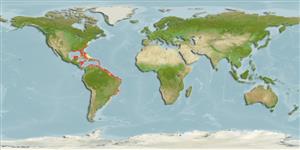Teleostei (teleosts) >
Carangaria/misc (Various families in series Carangaria) >
Polynemidae (Threadfins)
Etymology: Polydactylus: Greek, poly = a lot of + greek, daktylos = finger (Ref. 45335).
More on author: Linnaeus.
Environment: milieu / climate zone / depth range / distribution range
Ecology
Marine; brackish; demersal; depth range 0 - 55 m (Ref. 26912). Tropical; 41°N - 14°S, 93°W - 35°W (Ref. 57343)
Western Atlantic: New Jersey, USA to Salvador, Brazil. Reported to range to Uruguay (Ref. 9626). Not occurring in the northern and western Gulf of Mexico.
Size / Weight / Age
Maturity: Lm ? range ? - ? cm
Max length : 33.0 cm TL male/unsexed; (Ref. 57343); common length : 20.0 cm TL male/unsexed; (Ref. 3796)
Found on sandy and muddy bottoms of coastal waters, estuaries and mangroves, and occasionally in the surf (Ref. 57343). Young aggregate near river mouths (Ref. 57343). Common around islands (Ref. 9710). Nocturnal feeder, taking crustaceans, chaetognaths, plant material, and polychaetes (Ref. 57343). May have a prolonged spawning season (Ref. 57343).
Life cycle and mating behavior
Maturity | Reproduction | Spawning | Eggs | Fecundity | Larvae
Motomura, H., 2004. Threadfins of the world (Family Polynemidae). An annotated and illustrated catalogue of polynemid species known to date. FAO Spec. Cat. Fish. Purp. Rome: FAO. 3:117 p. (Ref. 57343)
IUCN Red List Status (Ref. 130435: Version 2024-1)
Threat to humans
Harmless
Human uses
Fisheries: minor commercial
Tools
Can't connect to MySQL database fbquizv2. Errorcode: Too many connections
